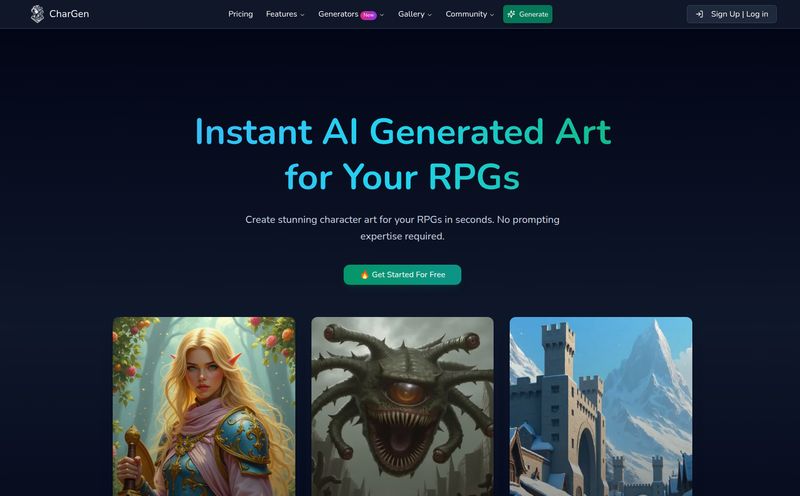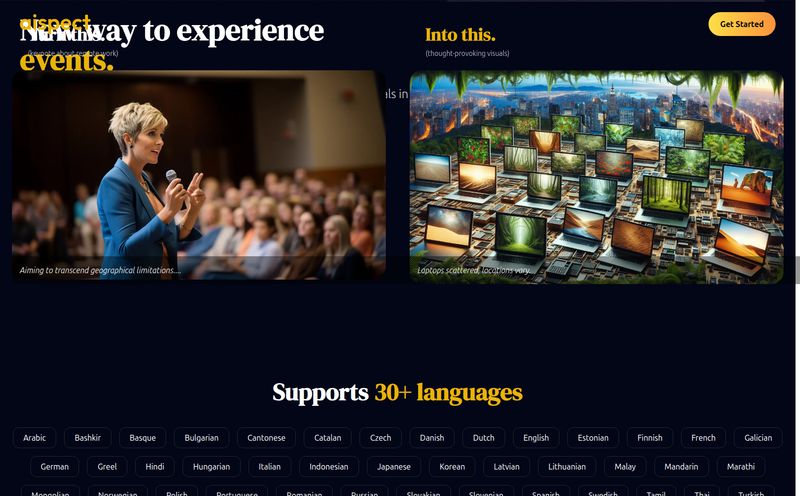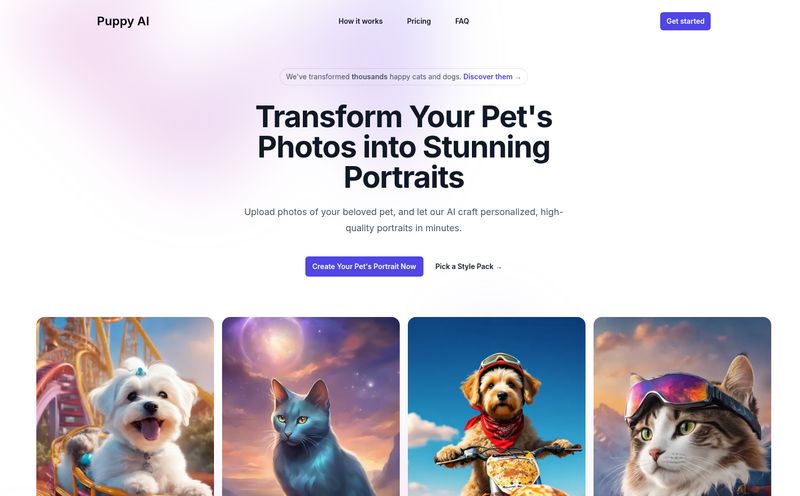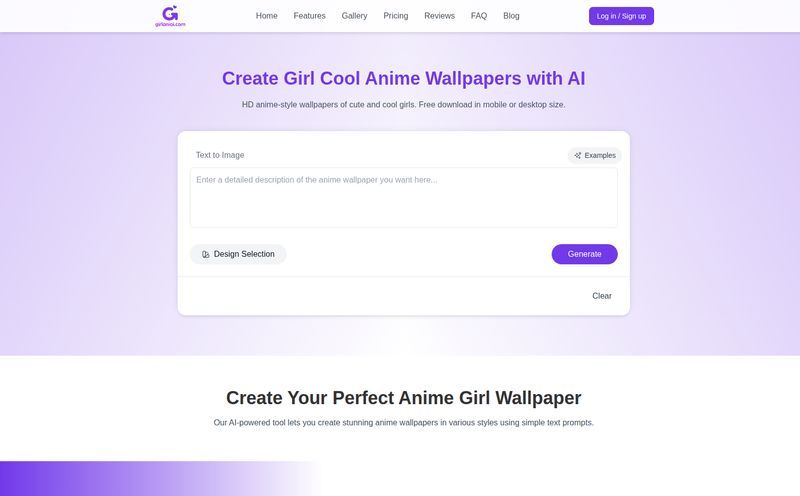We've all been there. Hunched over our keyboards at 2 AM, trying to conjure the perfect string of words to feed an AI image generator. "A hyper-realistic photograph of a ceramic vase, minimalist design, wabi-sabi aesthetic, soft morning light, sitting on a weathered oak table..." only to get back something that looks like a melted candlestick from a nightmare. The art of prompt engineering has become its own weird, niche skill set. Some of us love it. Me? I'm getting a little tired of it.
So when I stumbled upon a tool called Cre[ai]tion, my curiosity was definitely piqued. Their whole pitch? An AI design tool that ditches the text prompts almost entirely. It's built on a visual workflow. You show it what you like, and it creates. It’s less like giving orders to a robot and more like collaborating with a design partner who, thankfully, speaks the same visual language you do. A pretty bold claim in today's AI-saturated market. So, naturally, I had to see if it lived up to the hype.
So, What Exactly is Cre[ai]tion? (And Why Should You Care?)
Think of it this way: instead of a blank text box, Cre[ai]tion gives you a canvas. It’s an AI design platform focused on creating objects and products. We're talking furniture, packaging, electronics, fashion accessories—tangible things. It works by analyzing images you upload or select. You can start with a rough sketch, a photo of a texture you love, or a product you find inspiring. The AI then learns your taste and generates new concepts based on those visual inputs.
It’s a bit like digital alchemy. You're not trying to describe a gold goblet with words; you’re handing the AI a lump of lead (your initial image) and a picture of a crown (your inspiration) and telling it, “make me something that feels like this.” It’s an intuitive shift that, frankly, feels long overdue for designers who think in shapes and colors, not keywords.
The company claims it helps you create products 10x faster. A bold claim, but when you remove the endless trial-and-error of text prompting, I can see how the hours start to add up.
My First Impressions: A Workflow Without Words
Getting started is pretty straightforward. The interface is clean, centered around your 'board' where you collect ideas and generations. The first thing I tried was their “seamless fusion” feature. I uploaded a picture of a sleek, modern armchair and another of a piece of driftwood. I dragged them together, and what Cre[ai]tion produced was fascinating. It wasn't just a clumsy Photoshop mashup; it was a series of new chair concepts that genuinely incorporated the organic texture of the wood into the modern form of the chair. Some were duds, sure, but a few were legitimately cool.
There was no typing. Just clicking, dragging, and watching the possibilities unfold. It felt... liberating. I was guiding the process visually, course-correcting by selecting the generations that were closest to my vision and telling the AI to explore that direction further. It's a feedback loop that feels incredibly natural for a visual thinker.
![Cre[ai]tion](https://files.declom.com/Cre-ai-tion.jpg)
Visit Cre[ai]tion
The Standout Features That Got My Attention
After playing around for a while, a few features really stood out as being more than just gimmicks. These are the tools that make Cre[ai]tion a potentially serious contender for professional workflows.
The 'Visual Cooking' and Ingredient Extraction
This is probably the secret sauce. The platform has a feature they call “visual cooking,” which is a fantastic name for it. You can select an image and tell the AI to extract its ‘ingredients’—the color palette, the texture, the shape, or the overall style. Then, you can apply these ingredients to another design. Imagine taking the color palette from a sunset and applying it to a sneaker design, or taking the texture of a stone wall and applying it to a piece of packaging. It bypasses the need to describe those qualities with words, which are often inadequate anyway. How do you describe the exact texture of brushed metal in a way an AI will consistently understand? Here, you just show it.
Evolving Ideas with Seamless Fusion and Inpainting
I already mentioned the fusion, but it's worth a second look. The ability to morph two distinct ideas together is a powerful brainstorming tool. But what if you get a design that’s 90% perfect? That's where 'inpainting' comes in. It's called “precision in every detail” on their site. You can select just one part of a generated image—say, the leg of a chair—and have the AI regenerate only that part. This gives you a layer of control that's often missing in AI tools, helping you refine rather than just re-rolling the dice on the whole image.
Collaboration and Mapping Your Progress
For anyone working in a team, this is huge. Cre[ai]tion is built for collaboration. Multiple users can work on the same board, share ideas, and build on each other's generations. Every design iteration is automatically saved to your board, creating a visual map of your creative process. You can always go back to an earlier idea or see how one concept evolved into another. No more “which version was that again?” conversations. It's all laid out for you.
But Is It All Perfect? A Look at the Downsides
No tool is perfect, and Cre[ai]tion is no exception. While the visual workflow is its greatest strength, it also introduces a few limitations. Some might find the AI holds the reins a little too tightly. If you're a designer who revels in meticulous, pixel-perfect control and loves tweaking every single vector point, you might feel a bit constrained. It's a trade-off: you sacrifice some granular control for incredible speed and idea generation.
It's also a cloud-based platform, so you need a stable internet connection. No offline work on the plane for you. And, as with most powerful SaaS tools, the really juicy features are locked behind paywalls. The free plan is more of a taste test than a full meal.
Let's Talk Money: Breaking Down Cre[ai]tion's Pricing
The pricing structure is tiered, which is pretty standard. It caters to everyone from solo creators to massive enterprises. Let's break it down simply. I appreciate that they offer a free plan to get your feet wet.
| Plan | Price per Month | Who It's For |
|---|---|---|
| Free | €0 | Hobbyists and anyone curious to try the basic workflow. You get 20 generations a month. |
| Essentials | €14 | Freelancers and individual designers. This unlocks the core features like inpainting and 'visual cooking'. |
| Pro | €64 | Small agencies and power users who need more generations (3,000/month) and more boards. |
| Studio | €179 | Design studios and businesses. You get unlimited everything and priority support. |
| Enterprise | Let's Chat | Big brands (like their clients Nike and Google) who need custom-trained models and top-tier security. |
Note: Prices are a bit higher if you choose to pay monthly. All paid plans come with a 7-day free trial, which is a great way to test the premium features before committing.
Who is Cre[ai]tion Actually For?
So, who should drop what they're doing and try this? In my opinion, Cre[ai]tion is tailor-made for a few specific groups:
- Product and Industrial Designers: This is the bread and butter. If your job is to ideate physical objects, this tool could dramatically speed up your concepting phase.
- Creative Agencies: For teams needing to quickly generate and present multiple high-quality concepts to clients, this is a no-brainer.
- Marketing and Branding Teams: Need to mock up product variations or create conceptual imagery for a campaign? This is way faster than a traditional photoshoot or 3D modeling process.
It's less for the digital illustrator or fantasy artist who thrives on the narrative power of text prompts. This is a tool for makers and builders. The fact that they have users at places like Nike, C&A, and Google tells you it's built for serious commercial application.
Frequently Asked Questions about Cre[ai]tion
- Do I need to know how to write prompts to use Cre[ai]tion?
- Absolutely not! That's the whole point. The platform is designed around a visual, drag-and-drop workflow. Your images are your prompts.
- What kind of designs can I make with Cre[ai]tion?
- The platform excels at creating physical objects and products—things like furniture, electronics, packaging, footwear, and other consumer goods. It's less focused on illustrative or character-based art.
- Is there a free version of Cre[ai]tion?
- Yes, there is a free plan. It's a great way to experience the core workflow, but it's limited to 20 generations per month and lacks some of the more advanced features like inpainting.
- How is this different from Midjourney or DALL-E?
- The main difference is the input method. Midjourney and DALL-E are primarily text-to-image generators. Cre[ai]tion is an image-to-image generator that uses a visual workflow, making it more intuitive for many designers and focusing specifically on product design.
- Can I use Cre[ai]tion with my team?
- Yes, collaboration is a core component. The paid plans allow for team members to work together on shared design boards, making it ideal for agency and in-house design team environments.
Final Thoughts on a Wordless AI
After spending some quality time with Cre[ai]tion, I'm genuinely impressed. It’s not just another AI image generator in a sea of lookalikes. It's a thoughtfully designed tool that solves a real problem for a specific type of creative professional. By ditching the text prompt, it removes a major point of friction and makes the AI feel more like a natural extension of the creative mind.
Is it going to replace every other design tool? No, of course not. But for rapid ideation and concept development in the world of product design, it’s a powerful, intuitive, and maybe even fun new way to work. It’s a tool that speaks my language—the language of visuals. And for that, it's earned a spot in my digital toolbox.
References and Sources
- Cre[ai]tion Official Website: https://www.creaition.io/
- Cre[ai]tion Pricing Page: https://www.creaition.io/pricing



